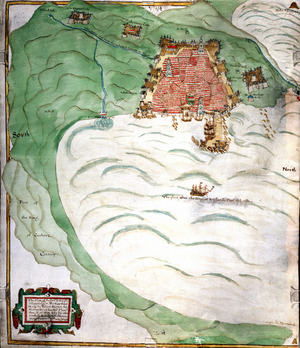English expedition to Algiers (1620–1621) facts for kids
The English Expedition to Algiers was a naval attack that happened between 1620 and 1621. It was ordered by King James I of England to stop piracy by certain groups in the Mediterranean Sea.
Quick facts for kids English Expedition to Algiers |
|||||||
|---|---|---|---|---|---|---|---|
| Part of Corsair War (1620-1621) | |||||||
 Depiction of Algiers in 1620 |
|||||||
|
|||||||
| Belligerents | |||||||
| Commanders and leaders | |||||||
| Mansell | Kassan Kaid Kussa | ||||||
| Strength | |||||||
| 20 ships | Unknown | ||||||
| Casualties and losses | |||||||
| Unknown | Unknown | ||||||
Contents
Why the English Sailed to Algiers
When King James I became king of England in 1603, things changed. Before, England and Algiers had a more peaceful relationship. But King James started allowing English ships to become "privateers."
What were Privateers?
Privateers were like legal pirates. They were given special permission by the king to attack and capture ships from other countries. King James encouraged his privateers to take ships and people from Muslim countries. This made relations with Algiers much worse.
Even though some privateer licenses were later taken back, English privateers still had a lot of freedom in the Mediterranean Sea. They often saw Algerian ships as fair targets.
The Expedition Begins
In 1620, a large English fleet was sent to Algiers. It was led by Admiral Robert Mansell, with help from Richard Hawkins and Thomas Button. Their main goal was to stop the "Barbary pirates" from controlling the important trade route through the Strait of Gibraltar.
After some talks, 40 English prisoners were freed in November 1620. Admiral Mansell then took part in a second trip in 1621.
The Battle for Algiers
On November 27, 1620, Mansell arrived in Algiers with 20 ships. He formally demanded that the leader of Algiers, called the Dey, release all English people and ships. He also wanted all pirates who had captured them to be caught or punished.
The Algerians seemed willing to agree and released 24 prisoners. Mansell knew this was only a small number. In the past six years, Algerians had captured 150 English ships. However, Mansell was not ready to fight, so he sailed away.
The Attack
Mansell returned to Algiers on May 21, 1621. Three days later, he launched his attack. The English used "fireships" against the Algerian pirate ships. Fireships were old ships filled with flammable materials, set on fire, and sent towards enemy ships to burn them.
Flames were seen shooting up in many places among the Algerian ships. But the English quickly ran low on ammunition. The Algerians took advantage of this and pushed the English away. The English expedition failed completely.
What Happened Next
The English attack made the Algerian pirates very angry. They not only raided merchant ships in the Mediterranean but also started attacking ships closer to the British mainland, even in the English Channel.
Over the years, these privateer attacks caused more damage to England than to Algiers. King James I then tried a different approach. In 1622, he negotiated directly with the Pasha of Algiers in Constantinople (modern-day Istanbul, Turkey).
English Ships in the Expedition
Here are some of the English ships that took part in the expedition:
| Ship | Guns | Commander | Notes | Ref. |
|---|---|---|---|---|
| Lion | 40 | Admiral Sir Robert Mansell | ||
| Vanguard | 40 | Vice-Admiral Sir Richard Hawkins | ||
| Rainbow | 40 | Rear-Admiral Sir Thomas Button | ||
| Constant Reformation | 40 | Captain Arthur Manwaring | ||
| Antelope | 34 | Captain Sir Henry Palmer | ||
| Convertine | 36 | Captain Thomas Love | ||
| Mercury | 20 | Joined 26 February 1621 | ||
| Spy | 18 | |||
| Golden Phoenix | 24 | Hired merchant ship | ||
| Samuel | 22 | |||
| Marygold | 21 | |||
| Zouche Phoenix | 26 | |||
| Barbary | 18 | |||
| Centurion | 22 | |||
| Primrose | 18 | |||
| Hercules | 24 | |||
| Neptune | 21 | |||
| Bonaventure | 23 | |||
| Restore | 12 | |||
| Marmaduke | 12 |

